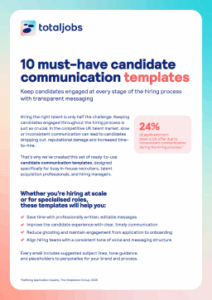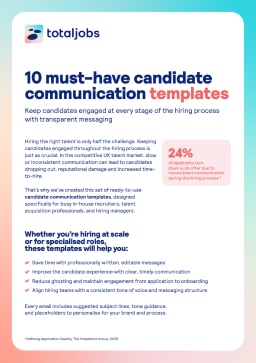
Managing candidate expectations in the recruitment process
Table of Contents
- Candidate or customer?
- Recommendations

Candidate Communication Templates
Almost a quarter (24%) of candidates would expect to be hired within just two weeks after applying for a role, according to the latest research from Totaljobs.
The need to manage candidate expectations has grown significantly in recent years. Increasingly, employers are becoming aware of the potential damage that can be done to a brand, as a result of a recruitment process that isn’t up to scratch in the candidate’s eyes.
Recruiters are battling not just to ensure they avoid inefficient hiring processes that result in missing out on the perfect candidate, but also with the pressure of making sure their brand image isn’t chipped away at because of a poor candidate experience.
If a candidate considers the recruitment process as lengthy or unorganised, 56% would be left with an overall negative image of the company and 44% would share this experience with their peers.
So, what is to be done to manage candidate expectations? The key is simple, but not always straightforward to execute – effective candidate communication. Identifying the best way to communicate and when is important.

Reading tip
How to improve candidate communication
Candidate or customer?
Of course, recruiters must identify whether a candidate has a suitable skillset and the potential to fit comfortably into the company culture. However, a recruiter’s role is also about keeping the brand in high esteem with applicants, after all the most skilled candidates will likely have a range of options. And even for those who don’t make the cut, it’s crucial to deliver a positive candidate experience that reinforces your brand favorably.
As long as both employer and candidate are selling themselves, and what they can offer, the recruitment process is also a customer experience.
The candidate is testing out how their needs would be met within a company, and there are plenty of vacancies to consider. Nowadays, candidates can afford to be choosy, as the majority of people looking for jobs are already in employment.
This “buying” process means that sometimes candidates can be left feeling detached from the brand, if the recruitment process is long-winded or not what they expected. Ultimately, a negative experience doesn’t just affect recruitment; it can damage your brand as a whole.
Recommendations
Be clear with timelines and stick to them
Establish realistic timings with the candidate. Whether this is communicated via a series of automated emails, a personal applicant dashboard, or via telephone depends on the resources at your disposal.
Seeing the difference this makes, many recruiters also follow structured candidate engagement strategies to keep applicants engaged throughout.
The important thing is that the candidate can refer to a timeline, so they are not left chasing their recruiter for updates unnecessarily.
Give feedback where you can
42% of candidates are frustrated when they don’t receive feedback following an application.
If they have not received constructive feedback, it means they will be less likely to apply for a more suitable role, or re-apply once their experience matches the position – after all, the candidate still does not know what the company is looking for beyond that initial job description if they have no feedback along the way.

Reading tip
How to give interview feedback to candidates
Personalise the experience
Time is not on the recruiter’s side, but in the long term personalising the experience as much as possible pays off.
A personalised experience with plenty of communication between recruiter and applicant (as long as it always serves a purpose) means a good customer experience.
It shines a good light on not just the recruiter, but the brand, recruitment process and customer service.

Streamline Your Candidate Communications
Save time and reduce drop-offs with ready-to-use email templates that guide candidates through each stage professionally.
Explore articles
Receive the latest recruitment resources and
advice to boost your hiring
By providing us with your details you agree to our privacy policy and for us to keep you updated with the latest news, events,
and special offers from Totaljobs.





